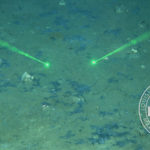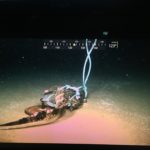Connecting the oceans to land are numerous carbon highways. These conduits bring food from land to the ocean, supporting an abundance of life. Our group explores these carbon chains and explores some potential methods of carbon delivery to the deep. Thus, alligators on the abyss.
At first it may seem fanciful that an alligator carcass might find its way to the deep. However, dozens of species of alligators and crocodiles are found across the globe, in high numbers, and often in coastal areas. Through either their normal migrating or foraging activities, or during flooding events, individuals may be found offshore in the ocean. If one of those individuals meets an unfortunate end, it may fall to the seafloor.

In prehistoric times, the impact to the deep oceans could have been even larger, as large reptiles such as ichthyosaurs and plesiosaurs dominated the sea. Deploying a reptile in the deep sea today may reveal the animals that specialized on the carcasses of long-extinct ancient emperors of the sea.

Earlier this year, our research group placed three alligator carcasses 1.5 miles deep on the seafloor of the Gulf of Mexico in the first-ever alligator fall experiment. Each of the three alligators met a different fate.
The first alligator had been on the bottom of the ocean for less than 24 hours. Despite the tough hide of the alligator, scavengers quickly got through and began to gorge themselves on the flesh of the alligator. Football-sized animals called giant isopods, relatives of rolly pollys or pillbugs, penetrated the hide in this short time-frame. This demonstrates the speed and precision with which deep-sea scavengers can utilize any carbon source, even food from land and freshwater systems.

A little over 60 miles to the east of the first alligator, the second alligator had been sitting on the seafloor for a little over a month and a half. All the soft tissue of the alligator had been removed by scavengers. A small animal called an amphipod was still darting around looking for scraps, but the only thing that remained was a skeleton. All of the soft tissue had been consumed. The spine curved just as it had been left. A depression in the sediments indicated where the full body once laid. The skull was turned over, likely by scavengers while picking at the flesh on the skull.

A fuzzy carpet covering the bones of the second alligator represented a brand-new species, previously unknown to science. These zombie worms, or Osedax, colonize the bones of many types of vertebrates and consume the lipids within. This was the first time zombie worms had ever been observed in the Gulf of Mexico or from an alligator fall. They also demonstrate yet another pathway in which carbon from land makes its way into deep-sea food webs.

Another 60 miles east lay the third alligator. It had only been eight days since it was laid on the seafloor. As the camera panned to the marking device, a floating bucket lid attached to a rope like an underwater flag, it became clear that the alligator was missing. All that remained where it had been dropped was an alligator-shaped depression in the sediments. Drag marks in the sediment paved a path to what remained of the alligator fall. An animal dragged this alligator 30 feet and left only the 45-pound weight and rope. The rope had been bitten completely through. To consume an alligator, and create this disturbance, the animal must have been of great size. We hypothesize that most likely a large shark, like a Greenland shark or sixgill shark, consumed this alligator whole.

Three alligator falls in the abyss met three very different ends, from being consumed by football-sized cousins of rolly polys, to zombie worms eating their bones, to a large shark dragging it away and consuming it whole. This research has given us a glimpse into what impact large reptiles had in past oceans, as well as the role they play today. It is clear that deep-ocean scavengers have no qualms about successfully and quickly consuming food that originated on land or freshwater.
Read more about this research in our group’s recent publication in PLOS One: “Alligators in the abyss: The first experimental reptilian food fall in the deep ocean.”







Fascinating article!